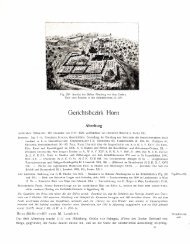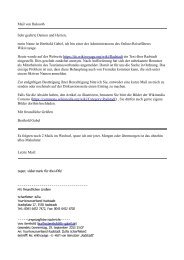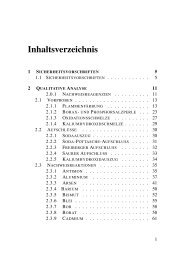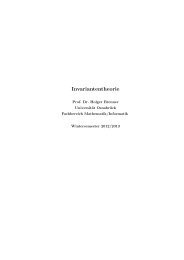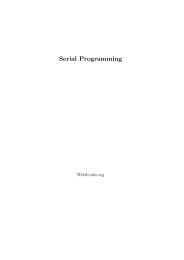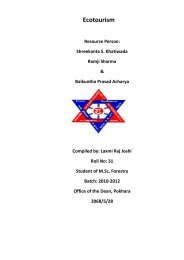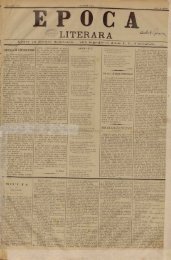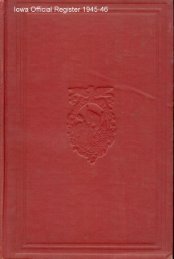Soziologische Klassiker - Upload server
Soziologische Klassiker - Upload server
Soziologische Klassiker - Upload server
Sie wollen auch ein ePaper? Erhöhen Sie die Reichweite Ihrer Titel.
YUMPU macht aus Druck-PDFs automatisch weboptimierte ePaper, die Google liebt.
162. Licenses<br />
162.1. GNU GENERAL PUBLIC LICENSE<br />
Version 3, 29 June 2007<br />
Copyright © 2007 Free Software Foundation, Inc. <br />
Everyone is permitted to copy and distribute verbatim copies of this license<br />
document, but changing it is not allowed. Preamble<br />
The GNU General Public License is a free, copyleft license for software and<br />
other kinds of works.<br />
The licenses for most software and other practical works are designed to take<br />
away your freedom to share and change the works. By contrast, the GNU<br />
General Public License is intended to guarantee your freedom to share and<br />
change all versions of a program–to make sure it remains free software for<br />
all its users. We, the Free Software Foundation, use the GNU General Public<br />
License for most of our software; it applies also to any other work released<br />
this way by its authors. You can apply it to your programs, too.<br />
When we speak of free software, we are referring to freedom, not price. Our<br />
General Public Licenses are designed to make sure that you have the freedom<br />
to distribute copies of free software (and charge for them if you wish),<br />
that you receive source code or can get it if you want it, that you can change<br />
the software or use pieces of it in new free programs, and that you know you<br />
can do these things.<br />
To protect your rights, we need to prevent others from denying you these<br />
rights or asking you to surrender the rights. Therefore, you have certain responsibilities<br />
if you distribute copies of the software, or if you modify it:<br />
responsibilities to respect the freedom of others.<br />
For example, if you distribute copies of such a program, whether gratis or for<br />
a fee, you must pass on to the recipients the same freedoms that you received.<br />
You must make sure that they, too, receive or can get the source code. And<br />
you must show them these terms so they know their rights.<br />
Developers that use the GNU GPL protect your rights with two steps: (1)<br />
assert copyright on the software, and (2) offer you this License giving you<br />
legal permission to copy, distribute and/or modify it.<br />
For the developers’ and authors’ protection, the GPL clearly explains that<br />
there is no warranty for this free software. For both users’ and authors’ sake,<br />
the GPL requires that modified versions be marked as changed, so that their<br />
problems will not be attributed erroneously to authors of previous versions.<br />
Some devices are designed to deny users access to install or run modified versions<br />
of the software inside them, although the manufacturer can do so. This<br />
is fundamentally incompatible with the aim of protecting users’ freedom to<br />
change the software. The systematic pattern of such abuse occurs in the area<br />
of products for individuals to use, which is precisely where it is most unacceptable.<br />
Therefore, we have designed this version of the GPL to prohibit<br />
the practice for those products. If such problems arise substantially in other<br />
domains, we stand ready to extend this provision to those domains in future<br />
versions of the GPL, as needed to protect the freedom of users.<br />
Finally, every program is threatened constantly by software patents. States<br />
should not allow patents to restrict development and use of software on<br />
general-purpose computers, but in those that do, we wish to avoid the special<br />
danger that patents applied to a free program could make it effectively<br />
proprietary. To prevent this, the GPL assures that patents cannot be used to<br />
render the program non-free.<br />
The precise terms and conditions for copying, distribution and modification<br />
follow. TERMS AND CONDITIONS 0. Definitions.<br />
“This License” refers to version 3 of the GNU General Public License.<br />
“Copyright” also means copyright-like laws that apply to other kinds of<br />
works, such as semiconductor masks.<br />
“The Program” refers to any copyrightable work licensed under this License.<br />
Each licensee is addressed as “you”. “Licensees” and “recipients” may be<br />
individuals or organizations.<br />
To “modify” a work means to copy from or adapt all or part of the work in<br />
a fashion requiring copyright permission, other than the making of an exact<br />
copy. The resulting work is called a “modified version” of the earlier work<br />
or a work “based on” the earlier work.<br />
A “covered work” means either the unmodified Program or a work based on<br />
the Program.<br />
To “propagate” a work means to do anything with it that, without permission,<br />
would make you directly or secondarily liable for infringement under<br />
applicable copyright law, except executing it on a computer or modifying<br />
a private copy. Propagation includes copying, distribution (with or without<br />
modification), making available to the public, and in some countries other<br />
activities as well.<br />
To “convey” a work means any kind of propagation that enables other parties<br />
to make or receive copies. Mere interaction with a user through a computer<br />
network, with no transfer of a copy, is not conveying.<br />
An interactive user interface displays “Appropriate Legal Notices” to the<br />
extent that it includes a convenient and prominently visible feature that (1)<br />
displays an appropriate copyright notice, and (2) tells the user that there is no<br />
warranty for the work (except to the extent that warranties are provided), that<br />
licensees may convey the work under this License, and how to view a copy<br />
of this License. If the interface presents a list of user commands or options,<br />
such as a menu, a prominent item in the list meets this criterion. 1. Source<br />
Code.<br />
The “source code” for a work means the preferred form of the work for<br />
making modifications to it. “Object code” means any non-source form of<br />
a work.<br />
A “Standard Interface” means an interface that either is an official standard<br />
defined by a recognized standards body, or, in the case of interfaces specified<br />
for a particular programming language, one that is widely used among<br />
developers working in that language.<br />
The “System Libraries” of an executable work include anything, other than<br />
the work as a whole, that (a) is included in the normal form of packaging<br />
a Major Component, but which is not part of that Major Component, and<br />
(b) serves only to enable use of the work with that Major Component, or to<br />
implement a Standard Interface for which an implementation is available to<br />
the public in source code form. A “Major Component”, in this context, means<br />
a major essential component (kernel, window system, and so on) of the<br />
specific operating system (if any) on which the executable work runs, or a<br />
compiler used to produce the work, or an object code interpreter used to run<br />
it.<br />
The “Corresponding Source” for a work in object code form means all the<br />
source code needed to generate, install, and (for an executable work) run<br />
the object code and to modify the work, including scripts to control those<br />
activities. However, it does not include the work’s System Libraries, or<br />
general-purpose tools or generally available free programs which are used<br />
unmodified in performing those activities but which are not part of the work.<br />
For example, Corresponding Source includes interface definition files associated<br />
with source files for the work, and the source code for shared libraries<br />
and dynamically linked subprograms that the work is specifically designed<br />
to require, such as by intimate data communication or control flow between<br />
those subprograms and other parts of the work.<br />
The Corresponding Source need not include anything that users can regenerate<br />
automatically from other parts of the Corresponding Source.<br />
The Corresponding Source for a work in source code form is that same work.<br />
2. Basic Permissions.<br />
All rights granted under this License are granted for the term of copyright<br />
on the Program, and are irrevocable provided the stated conditions are met.<br />
This License explicitly affirms your unlimited permission to run the unmodified<br />
Program. The output from running a covered work is covered by this<br />
License only if the output, given its content, constitutes a covered work. This<br />
License acknowledges your rights of fair use or other equivalent, as provided<br />
by copyright law.<br />
You may make, run and propagate covered works that you do not convey, without<br />
conditions so long as your license otherwise remains in force. You may<br />
convey covered works to others for the sole purpose of having them make<br />
modifications exclusively for you, or provide you with facilities for running<br />
those works, provided that you comply with the terms of this License in<br />
conveying all material for which you do not control copyright. Those thus<br />
making or running the covered works for you must do so exclusively on your<br />
behalf, under your direction and control, on terms that prohibit them from<br />
making any copies of your copyrighted material outside their relationship<br />
with you.<br />
Conveying under any other circumstances is permitted solely under the conditions<br />
stated below. Sublicensing is not allowed; section 10 makes it unnecessary.<br />
3. Protecting Users’ Legal Rights From Anti-Circumvention Law.<br />
No covered work shall be deemed part of an effective technological measure<br />
under any applicable law fulfilling obligations under article 11 of the WIPO<br />
copyright treaty adopted on 20 December 1996, or similar laws prohibiting<br />
or restricting circumvention of such measures.<br />
When you convey a covered work, you waive any legal power to forbid circumvention<br />
of technological measures to the extent such circumvention is<br />
effected by exercising rights under this License with respect to the covered<br />
work, and you disclaim any intention to limit operation or modification of the<br />
work as a means of enforcing, against the work’s users, your or third parties’<br />
legal rights to forbid circumvention of technological measures. 4. Conveying<br />
Verbatim Copies.<br />
You may convey verbatim copies of the Program’s source code as you receive<br />
it, in any medium, provided that you conspicuously and appropriately<br />
publish on each copy an appropriate copyright notice; keep intact all notices<br />
stating that this License and any non-permissive terms added in accord<br />
with section 7 apply to the code; keep intact all notices of the absence of<br />
any warranty; and give all recipients a copy of this License along with the<br />
Program.<br />
You may charge any price or no price for each copy that you convey, and you<br />
may offer support or warranty protection for a fee. 5. Conveying Modified<br />
Source Versions.<br />
You may convey a work based on the Program, or the modifications to produce<br />
it from the Program, in the form of source code under the terms of section<br />
4, provided that you also meet all of these conditions:<br />
* a) The work must carry prominent notices stating that you modified it, and<br />
giving a relevant date. * b) The work must carry prominent notices stating<br />
that it is released under this License and any conditions added under section<br />
7. This requirement modifies the requirement in section 4 to “keep intact<br />
all notices”. * c) You must license the entire work, as a whole, under this<br />
License to anyone who comes into possession of a copy. This License will<br />
therefore apply, along with any applicable section 7 additional terms, to the<br />
whole of the work, and all its parts, regardless of how they are packaged.<br />
This License gives no permission to license the work in any other way, but<br />
it does not invalidate such permission if you have separately received it. *<br />
d) If the work has interactive user interfaces, each must display Appropriate<br />
Legal Notices; however, if the Program has interactive interfaces that do not<br />
display Appropriate Legal Notices, your work need not make them do so.<br />
A compilation of a covered work with other separate and independent works,<br />
which are not by their nature extensions of the covered work, and which are<br />
not combined with it such as to form a larger program, in or on a volume of<br />
a storage or distribution medium, is called an “aggregate” if the compilation<br />
and its resulting copyright are not used to limit the access or legal rights of<br />
the compilation’s users beyond what the individual works permit. Inclusion<br />
of a covered work in an aggregate does not cause this License to apply to the<br />
other parts of the aggregate. 6. Conveying Non-Source Forms.<br />
You may convey a covered work in object code form under the terms of<br />
sections 4 and 5, provided that you also convey the machine-readable Corresponding<br />
Source under the terms of this License, in one of these ways:<br />
* a) Convey the object code in, or embodied in, a physical product (including<br />
a physical distribution medium), accompanied by the Corresponding Source<br />
fixed on a durable physical medium customarily used for software interchange.<br />
* b) Convey the object code in, or embodied in, a physical product<br />
(including a physical distribution medium), accompanied by a written offer,<br />
valid for at least three years and valid for as long as you offer spare parts or<br />
customer support for that product model, to give anyone who possesses the<br />
object code either (1) a copy of the Corresponding Source for all the software<br />
in the product that is covered by this License, on a durable physical medium<br />
customarily used for software interchange, for a price no more than your<br />
reasonable cost of physically performing this conveying of source, or (2) access<br />
to copy the Corresponding Source from a network <strong>server</strong> at no charge.<br />
* c) Convey individual copies of the object code with a copy of the written<br />
offer to provide the Corresponding Source. This alternative is allowed only<br />
occasionally and noncommercially, and only if you received the object code<br />
with such an offer, in accord with subsection 6b. * d) Convey the object code<br />
by offering access from a designated place (gratis or for a charge), and offer<br />
equivalent access to the Corresponding Source in the same way through<br />
the same place at no further charge. You need not require recipients to copy<br />
the Corresponding Source along with the object code. If the place to copy<br />
the object code is a network <strong>server</strong>, the Corresponding Source may be on a<br />
different <strong>server</strong> (operated by you or a third party) that supports equivalent<br />
copying facilities, provided you maintain clear directions next to the object<br />
code saying where to find the Corresponding Source. Regardless of what <strong>server</strong><br />
hosts the Corresponding Source, you remain obligated to ensure that it<br />
is available for as long as needed to satisfy these requirements. * e) Convey<br />
the object code using peer-to-peer transmission, provided you inform other<br />
peers where the object code and Corresponding Source of the work are being<br />
offered to the general public at no charge under subsection 6d.<br />
A separable portion of the object code, whose source code is excluded from<br />
the Corresponding Source as a System Library, need not be included in conveying<br />
the object code work.<br />
A “User Product” is either (1) a “consumer product”, which means any tangible<br />
personal property which is normally used for personal, family, or household<br />
purposes, or (2) anything designed or sold for incorporation into a<br />
dwelling. In determining whether a product is a consumer product, doubtful<br />
cases shall be resolved in favor of coverage. For a particular product received<br />
by a particular user, “normally used” refers to a typical or common use of<br />
that class of product, regardless of the status of the particular user or of the<br />
way in which the particular user actually uses, or expects or is expected to<br />
use, the product. A product is a consumer product regardless of whether the<br />
product has substantial commercial, industrial or non-consumer uses, unless<br />
such uses represent the only significant mode of use of the product.<br />
“Installation Information” for a User Product means any methods, procedures,<br />
authorization keys, or other information required to install and execute<br />
modified versions of a covered work in that User Product from a modified<br />
version of its Corresponding Source. The information must suffice to ensure<br />
that the continued functioning of the modified object code is in no case<br />
prevented or interfered with solely because modification has been made.<br />
If you convey an object code work under this section in, or with, or specifically<br />
for use in, a User Product, and the conveying occurs as part of a transaction<br />
in which the right of possession and use of the User Product is transferred to<br />
the recipient in perpetuity or for a fixed term (regardless of how the transaction<br />
is characterized), the Corresponding Source conveyed under this section<br />
must be accompanied by the Installation Information. But this requirement<br />
does not apply if neither you nor any third party retains the ability to install<br />
modified object code on the User Product (for example, the work has been<br />
installed in ROM).<br />
The requirement to provide Installation Information does not include a requirement<br />
to continue to provide support service, warranty, or updates for a<br />
work that has been modified or installed by the recipient, or for the User Product<br />
in which it has been modified or installed. Access to a network may be<br />
denied when the modification itself materially and adversely affects the operation<br />
of the network or violates the rules and protocols for communication<br />
across the network.<br />
Corresponding Source conveyed, and Installation Information provided, in<br />
accord with this section must be in a format that is publicly documented<br />
(and with an implementation available to the public in source code form),<br />
and must require no special password or key for unpacking, reading or copying.<br />
7. Additional Terms.<br />
“Additional permissions” are terms that supplement the terms of this License<br />
by making exceptions from one or more of its conditions. Additional permissions<br />
that are applicable to the entire Program shall be treated as though they<br />
were included in this License, to the extent that they are valid under applicable<br />
law. If additional permissions apply only to part of the Program, that part<br />
may be used separately under those permissions, but the entire Program remains<br />
governed by this License without regard to the additional permissions.<br />
When you convey a copy of a covered work, you may at your option remove<br />
any additional permissions from that copy, or from any part of it. (Additional<br />
permissions may be written to require their own removal in certain<br />
cases when you modify the work.) You may place additional permissions on<br />
material, added by you to a covered work, for which you have or can give<br />
appropriate copyright permission.<br />
Notwithstanding any other provision of this License, for material you add<br />
to a covered work, you may (if authorized by the copyright holders of that<br />
material) supplement the terms of this License with terms:<br />
* a) Disclaiming warranty or limiting liability differently from the terms of<br />
sections 15 and 16 of this License; or * b) Requiring preservation of specified<br />
reasonable legal notices or author attributions in that material or in the Appropriate<br />
Legal Notices displayed by works containing it; or * c) Prohibiting<br />
misrepresentation of the origin of that material, or requiring that modified<br />
versions of such material be marked in reasonable ways as different from the<br />
original version; or * d) Limiting the use for publicity purposes of names of<br />
licensors or authors of the material; or * e) Declining to grant rights under<br />
trademark law for use of some trade names, trademarks, or service marks; or<br />
* f) Requiring indemnification of licensors and authors of that material by anyone<br />
who conveys the material (or modified versions of it) with contractual<br />
assumptions of liability to the recipient, for any liability that these contractual<br />
assumptions directly impose on those licensors and authors.<br />
All other non-permissive additional terms are considered “further restrictions”<br />
within the meaning of section 10. If the Program as you received it,<br />
or any part of it, contains a notice stating that it is governed by this License<br />
along with a term that is a further restriction, you may remove that term.<br />
If a license document contains a further restriction but permits relicensing<br />
or conveying under this License, you may add to a covered work material<br />
governed by the terms of that license document, provided that the further<br />
restriction does not survive such relicensing or conveying.<br />
If you add terms to a covered work in accord with this section, you must<br />
place, in the relevant source files, a statement of the additional terms that<br />
apply to those files, or a notice indicating where to find the applicable terms.<br />
Additional terms, permissive or non-permissive, may be stated in the form of<br />
a separately written license, or stated as exceptions; the above requirements<br />
apply either way. 8. Termination.<br />
You may not propagate or modify a covered work except as expressly provided<br />
under this License. Any attempt otherwise to propagate or modify it is<br />
void, and will automatically terminate your rights under this License (including<br />
any patent licenses granted under the third paragraph of section 11).<br />
However, if you cease all violation of this License, then your license from<br />
a particular copyright holder is reinstated (a) provisionally, unless and until<br />
the copyright holder explicitly and finally terminates your license, and (b)<br />
permanently, if the copyright holder fails to notify you of the violation by<br />
some reasonable means prior to 60 days after the cessation.<br />
Moreover, your license from a particular copyright holder is reinstated permanently<br />
if the copyright holder notifies you of the violation by some reasonable<br />
means, this is the first time you have received notice of violation<br />
of this License (for any work) from that copyright holder, and you cure the<br />
violation prior to 30 days after your receipt of the notice.<br />
Termination of your rights under this section does not terminate the licenses<br />
of parties who have received copies or rights from you under this License.<br />
If your rights have been terminated and not permanently reinstated, you do<br />
not qualify to receive new licenses for the same material under section 10. 9.<br />
Acceptance Not Required for Having Copies.<br />
You are not required to accept this License in order to receive or run a copy<br />
of the Program. Ancillary propagation of a covered work occurring solely as<br />
a consequence of using peer-to-peer transmission to receive a copy likewise<br />
does not require acceptance. However, nothing other than this License grants<br />
you permission to propagate or modify any covered work. These actions infringe<br />
copyright if you do not accept this License. Therefore, by modifying<br />
or propagating a covered work, you indicate your acceptance of this License<br />
to do so. 10. Automatic Licensing of Downstream Recipients.<br />
Each time you convey a covered work, the recipient automatically receives a<br />
license from the original licensors, to run, modify and propagate that work,<br />
subject to this License. You are not responsible for enforcing compliance by<br />
third parties with this License.<br />
An “entity transaction” is a transaction transferring control of an organization,<br />
or substantially all assets of one, or subdividing an organization, or merging<br />
organizations. If propagation of a covered work results from an entity<br />
transaction, each party to that transaction who receives a copy of the work<br />
also receives whatever licenses to the work the party’s predecessor in interest<br />
had or could give under the previous paragraph, plus a right to possession of<br />
the Corresponding Source of the work from the predecessor in interest, if the<br />
predecessor has it or can get it with reasonable efforts.<br />
You may not impose any further restrictions on the exercise of the rights<br />
granted or affirmed under this License. For example, you may not impose a<br />
license fee, royalty, or other charge for exercise of rights granted under this<br />
License, and you may not initiate litigation (including a cross-claim or counterclaim<br />
in a lawsuit) alleging that any patent claim is infringed by making,<br />
using, selling, offering for sale, or importing the Program or any portion of<br />
it. 11. Patents.<br />
A “contributor” is a copyright holder who authorizes use under this License<br />
of the Program or a work on which the Program is based. The work thus<br />
licensed is called the contributor’s “contributor version”.<br />
A contributor’s “essential patent claims” are all patent claims owned or controlled<br />
by the contributor, whether already acquired or hereafter acquired,<br />
that would be infringed by some manner, permitted by this License, of making,<br />
using, or selling its contributor version, but do not include claims that<br />
would be infringed only as a consequence of further modification of the contributor<br />
version. For purposes of this definition, “control” includes the right<br />
to grant patent sublicenses in a manner consistent with the requirements of<br />
this License.<br />
Each contributor grants you a non-exclusive, worldwide, royalty-free patent<br />
license under the contributor’s essential patent claims, to make, use, sell, offer<br />
for sale, import and otherwise run, modify and propagate the contents of<br />
its contributor version.<br />
In the following three paragraphs, a “patent license” is any express agreement<br />
or commitment, however denominated, not to enforce a patent (such as<br />
an express permission to practice a patent or covenant not to sue for patent<br />
infringement). To “grant” such a patent license to a party means to make<br />
such an agreement or commitment not to enforce a patent against the party.<br />
If you convey a covered work, knowingly relying on a patent license, and the<br />
Corresponding Source of the work is not available for anyone to copy, free<br />
of charge and under the terms of this License, through a publicly available<br />
network <strong>server</strong> or other readily accessible means, then you must either (1)<br />
cause the Corresponding Source to be so available, or (2) arrange to deprive<br />
yourself of the benefit of the patent license for this particular work, or (3) arrange,<br />
in a manner consistent with the requirements of this License, to extend<br />
the patent license to downstream recipients. “Knowingly relying” means you<br />
have actual knowledge that, but for the patent license, your conveying the covered<br />
work in a country, or your recipient’s use of the covered work in a<br />
country, would infringe one or more identifiable patents in that country that<br />
you have reason to believe are valid.<br />
If, pursuant to or in connection with a single transaction or arrangement, you<br />
convey, or propagate by procuring conveyance of, a covered work, and grant<br />
a patent license to some of the parties receiving the covered work authorizing<br />
them to use, propagate, modify or convey a specific copy of the covered work,<br />
then the patent license you grant is automatically extended to all recipients<br />
of the covered work and works based on it.<br />
A patent license is “discriminatory” if it does not include within the scope of<br />
its coverage, prohibits the exercise of, or is conditioned on the non-exercise<br />
of one or more of the rights that are specifically granted under this License.<br />
You may not convey a covered work if you are a party to an arrangement<br />
with a third party that is in the business of distributing software, under which<br />
you make payment to the third party based on the extent of your activity of<br />
conveying the work, and under which the third party grants, to any of the parties<br />
who would receive the covered work from you, a discriminatory patent<br />
license (a) in connection with copies of the covered work conveyed by you<br />
(or copies made from those copies), or (b) primarily for and in connection<br />
with specific products or compilations that contain the covered work, unless<br />
you entered into that arrangement, or that patent license was granted, prior<br />
to 28 March 2007.<br />
Nothing in this License shall be construed as excluding or limiting any implied<br />
license or other defenses to infringement that may otherwise be available<br />
to you under applicable patent law. 12. No Surrender of Others’ Freedom.<br />
If conditions are imposed on you (whether by court order, agreement or otherwise)<br />
that contradict the conditions of this License, they do not excuse you<br />
from the conditions of this License. If you cannot convey a covered work<br />
so as to satisfy simultaneously your obligations under this License and any<br />
other pertinent obligations, then as a consequence you may not convey it at<br />
all. For example, if you agree to terms that obligate you to collect a royalty<br />
for further conveying from those to whom you convey the Program, the only<br />
way you could satisfy both those terms and this License would be to refrain<br />
entirely from conveying the Program. 13. Use with the GNU Affero General<br />
Public License.<br />
Notwithstanding any other provision of this License, you have permission to<br />
link or combine any covered work with a work licensed under version 3 of<br />
the GNU Affero General Public License into a single combined work, and to<br />
convey the resulting work. The terms of this License will continue to apply to<br />
the part which is the covered work, but the special requirements of the GNU<br />
Affero General Public License, section 13, concerning interaction through a<br />
network will apply to the combination as such. 14. Revised Versions of this<br />
License.<br />
The Free Software Foundation may publish revised and/or new versions of<br />
the GNU General Public License from time to time. Such new versions will<br />
be similar in spirit to the present version, but may differ in detail to address<br />
new problems or concerns.<br />
Each version is given a distinguishing version number. If the Program specifies<br />
that a certain numbered version of the GNU General Public License “or<br />
any later version” applies to it, you have the option of following the terms<br />
and conditions either of that numbered version or of any later version published<br />
by the Free Software Foundation. If the Program does not specify a<br />
version number of the GNU General Public License, you may choose any<br />
version ever published by the Free Software Foundation.<br />
If the Program specifies that a proxy can decide which future versions of the<br />
GNU General Public License can be used, that proxy’s public statement of



